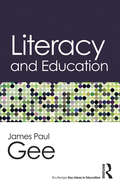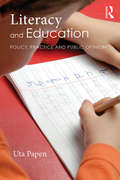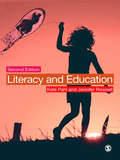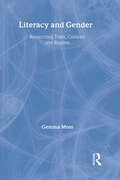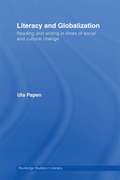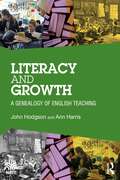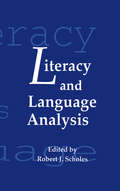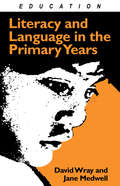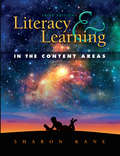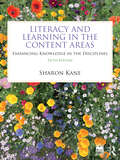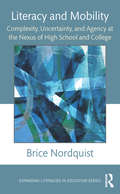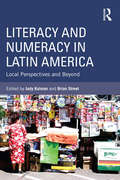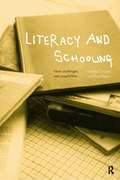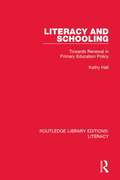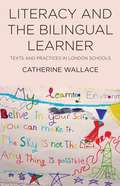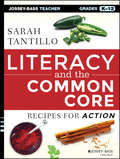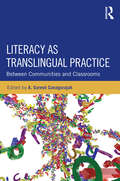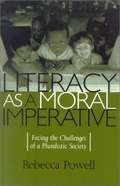- Table View
- List View
Literacy and Education: Ideology In Discourses (Routledge Key Ideas in Education)
by James Paul GeeLiteracy and Education tells the story of how literacy—starting in the early 1980s—came to be seen not as a mental phenomenon, but as a social and cultural one. In this accessible introductory volume, acclaimed scholar James Paul Gee shows readers how literacy "left the mind and wandered out into the world." He traces the ways a sociocultural view of literacy melded with a social view of the mind and speaks to learning in and out of school in new and powerful ways. Gee concludes by showing how the very idea of "literacy" has broadened into new literacies with words, signs, and deeds in contexts enhanced, augmented, and transformed by new technologies.
Literacy and Education: Policy, Practice and Public Opinion
by Uta PapenLiteracy is a perennial ‘hot topic’ in Britain and other English-speaking countries. Concerns about falling standards and a ‘literacy crisis’ are frequently raised. In response, governments initiate new policies and teaching guidelines. This book addresses the current policies, practices and media debates in England, the US, Scotland and Australia. Literacy and Education examines: How literacy is taught to children in primary schools; The place of phonics in current policies and the arguments made for and against it; How teachers deliver phonics lessons and how children engage with the method; The range of literacy practices children engage with throughout the school day and how they contribute to literacy learning; The contributions a social and critical perspective on literacy can make to current debates regarding teaching strategies; A wide range of research conducted in the UK, North America, Australia and other countries. Bringing together policy, practice and public debate and drawing on the author’s extensive research in a primary school, this essential new textbook provides questions and tasks for readers to engage with. Literacy and Education is ideal for advanced undergraduate and postgraduate students of literacy and education and students on PGCE courses. It will also be of interest to researchers and teachers.
Literacy and Education: Understanding The New Literacy Studies In The Classroom (New Perspectives On Language And Education Ser. #4)
by Dr Kate Pahl Dr Jennifer RowsellLiteracy and Education continues to be an accessible guide to current theory on literacy with practical applications in the classroom. This new edition has a new focus on the ecologies of literacy and on participatory and visual ways of researching literacy. The new edition examines - new literacy studies - material culture and literacy - digital literacies - the ecological, place-based approaches to literacy education - timescales and identities, and - ways in which research has moved on to inform literacy education. Classroom teachers, teacher trainers and students of literacy will find this a user-friendly guide to new theory in literacy education, clearly demonstrating how to implement this theory in the classroom in a way that is inclusive and listens to the students of today.
Literacy and Gender: Researching Texts, Contexts and Readers (Literacies)
by Gemma MossWhy are girls outperforming boys in literacy skills in the Western education system today? To date, there have been few attempts to answer this question. Literacy and Gender sets out to redress this state of affairs by re-examining the social organization of literacy in primary schools. In studying schooling as a social process, this book focuses on the links between literacy, gender and attainment, the role school plays in producing social difference and the changing pattern of interest in this topic both within the feminist community and beyond. Gemma Moss argues that the reason for girls’ relative success in literacy lies in the structure of schooling and in particular the role the reading curriculum plays in constructing a hierarchy of learners in class. Using fine-grained ethnographic analysis of reading in context, this book outlines methods for researching literacy as a social practice and understanding how different versions of what counts as literacy can be created in the same site.
Literacy and Globalization: Reading and Writing in Times of Social and Cultural Change (Routledge Research in Literacy)
by Uta PapenUsing literacy practices in the newly independent post-apartheid Namibia as a lens through which to examine the effects of globalisation, this broad case study looks at issues surrounding tourism, state control and the new forces of consumerism. By placing literacy at the centre of an investigation into social and cultural change as experienced by individuals, Papen shows that in times of change, reading and writing are always implicated in structures of power and inequality. The book considers language practices that can exclude some members of Namibian society and also looks at the strategies used by local people to accommodate and even embrace the onward march of global English and the influx of foreign visitors, practices and modes of commerce and interaction.
Literacy and Growth: A Genealogy of English Teaching (National Association for the Teaching of English (NATE))
by John Hodgson Ann HarrisLiteracy and Growth is a unique genealogical study of English teaching in the UK and abroad since the 18th century. Focusing specifically on the concepts of literacy and growth, this book explores key moments in the development of ideas about English teaching. Hodgson and Harris reveal the Enlightenment forebears of such contemporary concepts as “cultural capital” and “critical literacy”; the significance of “growth” to the writers and social critics who opposed Victorian Utilitarianism; and the 20th-century influences that established English as a humane study, including the Newbolt Report, the Cambridge Scrutiny group, and the London School of Percival Gurrey and James Britton. The authors examine unpublished Dartmouth Conference papers to reconsider John Dixon’s construction of “growth” in his seminal report Growth through English (1967). They reflect on the turbulent aftermath of Dartmouth, the changes in the “growth” model following the cultural turn in English studies, and the politics behind the shift from “English” to “literacy” in the 1990s. Importantly, they redefine the growth model for the 21st century to support teachers and students in the current context of performativity, high-stakes assessment, the “knowledge curriculum”, and artificial intelligence.Essential reading for tutors and students of English and literacy as well as policymakers in the subject area, this book will engage all those interested in the history and philosophy of English in education. It will be a key resource for those involved in the education and training of English teachers, as well as those undertaking research in English education.
Literacy and ICT in the Primary School: A Creative Approach to English
by Andrew RuddBy clearly outlining how ICT can enhance and improve children’s learning, this book unlocks the full potential of ICT within the classroom. Stimulating, useful and free of jargon, the book provides many practical examples to show teachers where, when and how ICT can be used effectively within literacy teaching. It provides advice on: teaching creatively using ICT in the Foundation Stage making the most of your resources planning and assessment. Rooted in the practical realities of the classroom, this book will support both trainee and qualified teachers in providing rich and creative literacy experiences through the use of technology.
Literacy and Identity Through Streaming Media: Kids, Teens, and Representation on Netflix (Expanding Literacies in Education)
by Damiana Gibbons PylesIn this book, Damiana Gibbons Pyles guides readers through the fast-changing landscape of digital streaming services such as Netflix and explores their impact on children’s and teens’ identities. Children interact with streaming media in novel, hidden, and unforeseen ways that shape their digital, material, affective, and embodied worlds. By analyzing how Netflix represents gender, race, and ethnicities, Gibbons Pyles explores how this new media phenomenon portrays and influences young people’s development and sense of self, and how streaming media pushes children and teens to particular ways of being in its interfaces, algorithms, and content. Drawing primarily on Bakhtinian, feminist, and female Black scholarship, her incisive analysis reveals how the new media streaming phenomenon molds children’s understandings of their ways of being in the world. Ideal for scholars and graduate students in literacy education, media studies, and communication, the text is an illuminating view into the hidden role of streaming services as an essential, complex component of literacy scholarship.
Literacy and Language Analysis
by Robert J. ScholesThis volume investigates the interconnections between language and literacy in terms of the structures of language as well as the linguistic contexts of literacy. The work for this book was generated in order to focus on studies of the acquisition and impact of literacy on traditional assertions of linguistic analysts. The contributors show that claims regarding descriptions of the linguistic competence of native speakers contain phonemic, morphemic, and sentential constructs applicable only to literate language users. They also suggest that syntactic formalities -- elements lacking extensional reference -- are unlikely in the absence of literacy, and that the notions of "sentencehood" and syntactic well-formedness are functions of literacy. Finally, the book reviews the basic notions of literary relativity and the role of literacy in communication and civilization.
Literacy and Language in East Asia: Shifting Meanings, Values and Approaches
by Peter Kell Marilyn KellThis book critically explores why some Asian nations are on top of the world in students' achievement tests in reading and literacy, yet governments and industry in these nations are anxious about a crisis in education. Why are governments anxious about the capabilities and skills of school and university graduates in a global economy when there is a Asian economic boom? The authors explore questions about how the Asian countries value test-based examination curriculum and its influence on the practices of teaching learning and the lives of young people in Asia. The authors describe the challenge of change for East Asian nations to develop more relevant approaches to literacy and language and more inclusive societies focussed on the needs of young people and not exam results.
Literacy and Language in the Primary Years
by Jane Medwell David WrayLinking the development of reading, writing, speaking and listening, this book offers a distinctive holistic approach to literacy and language acquisition. It emphasizes the value of active, collaborative learning, and includes sections on literacy accross the primary curriculum, new technology and assessment. Each chapter is linked to a component of the National Curriculum Programme and contains points of interest, sources of further information and suggestions for follow-up actvities in the classroom.
Literacy and Learning in the Content Areas
by Sharon KaneThe 3rd Edition of Literacy & Learning in the Content Areas helps readers build the knowledge, motivation, tools, and confidence they need as they integrate literacy into their middle and high school content area classrooms. Its unique approach to teaching content area literacy actively engages preservice and practicing teachers in reading and writing and the very activities that they will use to teach literacy to their own studentsin middle and high school classrooms . Rather than passively learning about strategies for incorporating content area literacy activities, readers get hands-on experience in such techniques as mapping/webbing, anticipation guides, booktalks, class websites, and journal writing and reflection. Readers also learn how to integrate children's and young adult literature, primary sources, biographies, essays, poetry, and online content, communities, and websites into their classrooms. Each chapter offers concrete teaching examples and practical suggestions to help make literacy relevant to students' content area learning. Author Sharon Kane demonstrates how relevant reading, writing, speaking, listening, and visual learning activities can improve learning in content area subjects and at the same time help readers meet national content knowledge standards and benchmarks.
Literacy and Learning in the Content Areas: Enhancing Knowledge in the Disciplines
by Sharon KaneThe fifth edition of Literacy and Learning in the Content Areas: Enhancing Knowledge in the Disciplines provides readers with the knowledge, motivation, tools, and confidence for integrating literacy in their disciplinary classrooms. Offering a literature-based approach to teaching disciplinary literacy, the new edition shares important ways in which teachers of courses in the disciplines can enhance student learning of subject matter and skills while also fostering their growth in the many facets of literacy. Throughout each chapter, Kane provides engaging and creative strategies and activities to make literacy come alive in discipline-specific courses and to encourage students to explore and learn in the classroom. Embedded in each chapter are examples, resources, and strategies to help readers actively engage with and implement literacy practices. These features include Teaching in Action examples by subject area; Activating Prior Knowledge activities to stimulate critical thinking to prepare readers to learn complex theoretical and conceptual material about teaching, learning, and literacy; and end-of-chapter Application Activities to apply field experiences to classroom use.New to the Fifth Edition Every chapter of this new edition is updated to reflect the current approaches, standards, and benchmarks for discipline-specific literacy A new introduction with reading activities for professors to exemplify a common reading experience with their students, supported by online reading materials New book talks to highlight books that show disciplinary thinking in action, including literature related to art, physical education, economics, computer science, engineering, food science, music, robotics, environmental science, family and consumer science, and technology Expanded practical instructional strategies, with new examples focused on STEAM (science, technology, engineering, art, math) fields and topics relating to diversity and language, ESL/ENL, and modern language learning Updated examples and activities to emphasize students’ active involvement in their own learning
Literacy and Learning in the Content Areas: Enhancing Knowledge in the Disciplines (Fourth Edition)
by Sharon Kane<p>The Fourth Edition of Literacy and Learning in the Content Areas: Enhancing Knowledge in the Disciplines provides readers with the knowledge, motivation, tools, and confidence for integrating literacy in their disciplinary classrooms. Offering an original, literature-based approach to teaching disciplinary literacy, the new edition shares important ways in which teachers of courses in the disciplines can enhance student learning of subject matter and skills while also fostering their growth in the many facets of literacy. Throughout each chapter, Kane provides engaging and creative strategies and activities to make literacy come alive in discipline-specific courses and to encourage students to explore and learn in the classroom. <p>Embedded in each chapter are examples, resources, and strategies to help readers actively engage with and implement literacy practices. These features include Teaching in Action examples by subject area; Activating Prior Knowledge activities to stimulate critical thinking to prepare readers to learn complex theoretical and conceptual material about teaching, learning, and literacy; and end-of-chapter Application Activities to apply field experiences to classroom use. <p>New to the Fourth Edition: <p> <li>Every chapter of this new edition is updated to reflect the current approaches, standards, and benchmarks for discipline-specific literacy. <li>Enhanced Companion Website with BookTalks to introduce relevant books in many genres and subjects, encouraging readers to explore the books for themselves and providing a model for BookTalks in their own classrooms. <li>Expanded practical instructional strategies for teaching literacy in math, science, and social studies. <li>Updated to include newly published titles in children’s literature, young adult literature, and nonfiction.</li> </p>
Literacy and Mobility: Complexity, Uncertainty, and Agency at the Nexus of High School and College
by Brice NordquistPushing forward research on emerging literacies and theoretical orientations, this book follows students from different tracks of high school English in a "failing" U.S. public school through their first two years in universities, colleges, and jobs. Analytical and methodological tools from new literacy and mobility studies are employed to investigate relations among patterns of movement and literacy practices across educational institutions, neighborhoods, cultures, and national borders. By following research participants’ trajectories in and across scenes of literacy in school, college, home, online, in transit, and elsewhere, the work illustrates how students help constitute and connect one scene of literacy with others in their daily lives; how their mobile literacies produce, maintain, and disrupt social relations and identities with respect to race, gender, class, language, and nationality; and how they draw upon multiple literacies and linguistic resources to accommodate, resist, and transform dominant discourses.
Literacy and Motivation: Reading Engagement in individuals and Groups
by Catherine E. Snow Ludo VerhoevenThe central question in this volume is how to create a society of "engaged readers" in today's world, where reading is increasingly overruled by other media, such as television and personal computers. Engaged readers, as the term is used in this book, means readers who are socially interactive, strategic, and motivated. This state-of-the-art review contains research on integrating cognitive, social, and motivational aspects of reading and reading instruction, the chapter authors argue that coming to grips with the notion of engagement in literacy requires redefining literacy itself to acknowledge the degree to which it is not only a cognitive accomplishment, but a social activity and an affective commitment as well. Promoting literacy acquisition thus requires interventions that address attitudes and beliefs as much as those that assure cognitive changes in learners. Equally important, the authors posit that literacy engagement involves the integration of cognitive strategies and motivational goals during literate activities. This necessary link between literacy and motivation is addressed from a variety of perspectives. Acknowledging the value of cross-national and cross-cultural comparisons, the book features chapters on the promotion of literacy in different regions around the world.
Literacy and Multimodality Across Global Sites (Routledge Research in Literacy #9)
by Maureen KendrickOver the past three decades, our conceptualizations of literacy and what it means to be literate have expanded to include recognition that there is a qualitative difference in how we communicate through modalities such as the visual, audio, spatial, and linguistic and that different modes are combined in complex ways to make meaning. The field of multimodality is concerned with how human beings use different modes of communication to represent or make meaning in the world. Despite the rapid growth of international research in this area, accounts of a broader range of global sites, particularly economically under-resourced and culturally diverse contexts such as Sub-Saharan Africa, remain under-researched and under-represented in the literature. This book contextualizes a range of literacies including health literacies, community literacies, family literacies, and multilingual literacies within broader modes of communication, most specifically play and the visual. The claim is that powerful pedagogies, methodologies and theories can be constructed by taking a more detailed look at multimodal meaning-making in diverse contexts. By describing and analyzing multimodal practices and texts across a diverse range of contexts, the book highlights different constructs, issues and emerging questions dealing with the study of literacies and multimodality.
Literacy and Numeracy in Latin America: Local Perspectives and Beyond
by Brian Street Judy KalmanLatin American Literacy and Numeracy Studies (LALNS) are fairly unknown in other parts of the world. This book charts new directions in LALNS and explores the relationship between these studies and international perspectives. Calling upon social practice approaches, New Literacy Studies, sociolinguistics, discourse analysis and other paradigms, the contributors identify both convergent and divergent literacy and numeracy issues within the region as well as beyond the Latin American context. Literacy and Numeracy in Latin America moves the field forward by bringing LALNS into wider focus and helping readers to understand the synergy with work from other perspectives and from other parts of the world and the implications for theory and practice. A lack of translated work until now between Latin America and, in particular, the UK, US, and Europe, has meant that such important overlaps between areas of study have gone unappreciated. In this way this volume is the first of its kind, a significant and original contribution to the field.
Literacy and Power (Language, Culture, and Teaching Series)
by Hilary JanksHilary Janks addresses key questions about literacy and power in this landmark text that is both engaging and accessible. Her central argument is that competing orientations to critical literacy education ? domination (power), access, diversity, design ? foreground one over the other, but are crucially interdependent and need to work together to create possibilities for redesign and social action that serve a social justice agenda. She examines the theory underpinning each orientation, and develops new theory in the argument for interdependence and integration. Sitting at the interface between theory and practice, constantly moving from one to the other, the text is rich with examples of how to use these orientations in real teaching contexts, and how to use them to counterbalance one another. In the groundbreaking final chapter Janks considers how the rationalist underpinning of critical literacy tends to exclude the non-rational shows ways of working ‘beyond reason’ ? pleasure and play, desire and the unconscious ? and makes the case that these need to be taken seriously given their power to cut across the work of critical literacy educators working from any orientation.
Literacy and Schooling
by Frances Christie and Ray MissonThis book is intended to offer an introduction to some major themes in literacy education. Literacy has become an important issue both in the UK and internationally, and this book aims to inform discussions while assisting teachers to reflect on their work as literacy teachers. Literacy is important from the earliest years through all the years of formal education, and so this book covers work with students in the full range of schooling, and in a number of different subject areas. Topics covered include: *the nature and use of texts *the reading positions that are constructed in texts and their ideological implications *the ways in which written texts change as students grow older *moving from the early years through to secondary education *the implications of Information Technology for literacy teaching Frances Christie is Foundation Professor of Language and Literacy Education at the University of Melbourne. Ray Misson is Senior Lecturer in Language and Literacy Education at the University of Melbourne.
Literacy and Schooling: Towards Renewal in Primary Education Policy (Routledge Library Editions: Literacy #8)
by Kathy HallOriginally published in 2004. In this book Kathy Hall analyses recent educational reform in England relating to primary education and literacy. By taking account of themes such as globalisation, teacher education, children's learning and especially literacy, she develops a critique of government reactions and explores alternative responses to the crucial issues of our time. The book concludes with policy recommendations based on evidence drawn from a range of perspectives. Inviting the reader to consider what is happening in primary education generally, and in literacy more specifically, the book will prove both thought– and action– provoking.
Literacy and the Bilingual Learner: Texts and Practices in London Schools
by Catherine WallaceLiteracy and the Bilingual Learner explores the literacy development of bilingual learners in London (UK) schools and colleges through a series of vignettes and case studies of learners and their educational experiences.
Literacy and the Common Core: Recipes for Action
by Sarah TantilloTools and Insights for Meeting and Exceeding the Common Core Standards Literacy and the Common Core offers K-12 teachers clear guidance on how to design units, lessons, and objectives to meet the Common Core State Standards in English Language Arts; it's filled with practical strategies that teachers can use immediately to target key standards; and it describes how to analyze the standards to support instructional planning and curriculum development.This book aims to make life a little easier for everyone--teachers, school leaders, parents, and students--as we all strive to prepare students for college and the careers they most desire. The book includes practical tools,templates, and rubrics ready to be downloaded and customized to meet your needs. Additional resources may be found on the companionsite, www.literacycookbook.com. Here are just a few of the essential topics addressed: Which standards to start with and how to tackle them. How to bridge the gap when students are not on grade level. How to engage and support parents. How to teach students to write effectively. How to translate the standards for actual use. Take the recipes in this book, make them your own, and enjoyyour new "Common Core Master Chef" status!
Literacy as Translingual Practice: Between Communities and Classrooms
by A. Suresh CanagarajahThe term translingual highlights the reality that people always shuttle across languages, communicate in hybrid languages and, thus, enjoy multilingual competence. In the context of migration, transnational economic and cultural relations, digital communication, and globalism, increasing contact is taking place between languages and communities. In these contact zones new genres of writing and new textual conventions are emerging that go beyond traditional dichotomies that treat languages as separated from each other, and texts and writers as determined by one language or the other. Pushing forward a translingual orientation to writing—one that is in tune with the new literacies and communicative practices flowing into writing classrooms and demanding new pedagogies and policies— this volume is structured around five concerns: refining the theoretical premises, learning from community practices, debating the role of code meshed products, identifying new research directions, and developing sound pedagogical applications. These themes are explored by leading scholars from L1 and L2 composition, rhetoric and applied linguistics, education theory and classroom practice, and diverse ethnic rhetorics. Timely and much needed, Literacy as Translingual Practice is essential reading for students, researchers, and practitioners across these fields.
Literacy as a Moral Imperative: Facing the Challenges of a Pluralistic Society
by Rebecca PowellPowell argues that literacy instruction should encourage social responsibility and civic action and should nurture a culture of compassion and care.
